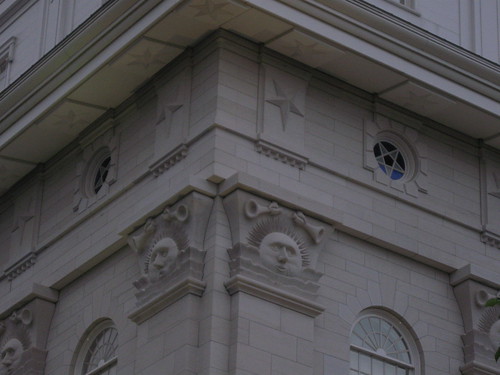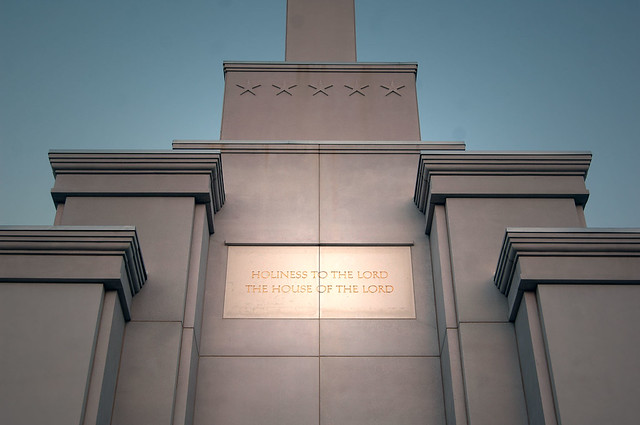I've already written about
sunstones and
moonstones on temples built by The Church of Jesus Christ of Latter-day Saints. Now I'd like to write about starstones. I'll begin with five pointed stars and gradually progress through the various types of stars on Latter-day Saints temples.
 |
| Nauvoo Temple corner with various symbolic stones |
The Nauvoo Illinois Temple was the first to use symbolic sun, moon, and star stones. As I pointed out earlier, these were meant to represent the vision of John in Revelation 12:1
And there appeared a great wonder in heaven; a woman clothed with the sun, and the moon under her feet, and upon her head a crown of twelve stars:
In this context, the stars would not represent the Telestial Kingdom of God, or lowest heaven. This makes sense, as the stars are above the sunstones on the Nauvoo Temple. There are several types of stars on the Nauvoo Temple. In the photo (
original here) you can see the five pointed stars are directly above the sunstones. These stars are also upside down and have an elongated bottom point. First off, they have no satanic meaning. Upside down stars were first used to represent evil things decades after the temple was built (see
FAIR article). Inverted stars have been (and still are) used by many churches and organizations worldwide. When I visited Illinois I noticed that buildings built in the 1800s often had inverted five pointed stars, even ones built far away from the saints. I like how the inverted stars look on the Nauvoo Temple. Notice that there are also red, white, and blue inverted star windows on the temple as well. There are also right side up stars on the Nauvoo Temple on the tower and just below the tower. You can see them in
this picture. I count 2 sets of 40 stars on the tower (possibly 40 more on the overhang for a symbolic 120 or 3X40) and a bunch more lower down along the railing. In the Salt Lake Temple discussion I'll talk more about what right side up stars can mean, especially on towers and related to the number 40.
 |
| St George Temple celestial room |
The St. George Utah Temple doesn't have exterior stars, but it does have some stars in the terrestrial and celestial rooms as well as the assembly hall. These are not inverted. I think they are used simply to represent heaven or the heavens, which is a common way to interpret a star. This would explain how they can be used in a room representing the celestial kingdom.
 |
| Logan Temple Starstone |
There is some added symbolism in the inverted star, particularly with an elongated point. When the Logan Utah Temple was being built, the saints again added inverted five pointed stars. They said that it represented the Star of the Morning, a symbol of Christ (see aforementioned FAIR article). This makes sense as the morning star, actually the planet Venus, looks elongated because it is lit by the sun. It is the bright morning and evening star, the first and last star in the sky, another way of saying the alpha and omega, the beginning and the end. The symbol can also have another meaning and represent us getting our light from Jesus Christ as the morning and evening star gets its light from the sun. The Logan Temple has two of these star stones (one on the west center tower and one on the east center tower) and they are almost the only symbol on the temple (the towers, keystones, and scroll stones are the other symbols). You can see the original photo I've used
here.
The Salt Lake Temple includes many star stones. Among the five pointed stars represented are both point up and inverted stars. Most are found on keystones above windows and doors. The inverted stars represent Jesus Christ and the Morning Star and the other symbolism discussed above on the Logan Temple. These stones are between the moon and sun stones so they do not relate to John's vision. Original plans were going to have the inverted stars with an elongated bottom point, but the completed temple has equal length points on all stars.
The use of point side up and inverted stars may also imply that some stars have an additional meaning. It is likely that the point side up stars represent the heavens in general. The point up stars are found on the east and west ends of the temple, and the point down stars are found on the main body of the temple. Many point up stars are above the level of the sunstones and are used to represent John's vision as was done on the Nauvoo Temple. You might notice in the north visitor's center on Temple Square that there are planter boxes near the Christus statue that have upside down five pointed stars with elongated points. For a short while the north visitor's center was a temporary annex to the Salt Lake Temple while the current annex was being built.
On the east towers there are an additional forty point side up stars. Some can be seen in
this photo between the cloud stones (also known as trumpet stones). The absence of these stars on the west towers (a similar absence on west towers has been copied in other temples) implies that they have special meaning to the Melchizedek Priesthood that the east towers represent. In the book
Sacred Walls: Learning From Temple Symbols by Gerald E. Hansen Jr., it states:
According to scholar Richard Oman, the forty five-pointed stars, found only on the three eastern towers, may refer also to God's gift of priesthood to guide us, in that they may represent the great and noble spirits of premortality whom God assigned to be rulers in His kingdom.
I'm not sure how this symbolism is derived, but it sounds interesting. The number forty is also symbolic. It is worth noting that the east towers have these forty point side up five-pointed stars forming a sort of constellation, while the west side has the big dipper constellation made out of six-pointed stars. So the towers representing each priesthood have their own unique stars.
The Laie Hawaii Temple also has a
five pointed star. It is not really a starstone, but rather a part of the relief sculptures that surround the top of the temple. I believe this one was meant to represent the Star of Bethlehem, which is a common meaning of starstones. I didn't mention before, but the inverted stars on temples may also refer to the Star of Bethlehem that looked down on Jesus Christ's location. On a temple then, it can mean that as the Star of Bethlehem pointed to where Christ was, these starstones are signifying that He can be found in this temple.
 |
| Washington D.C. Temple Star |
The Washington D.C. Temple used stars again. In this case they were metal star medallions on the doors. You can see the full image on the left
here. Another great view of these doors is
here. In this usage, the stars clearly can refer to the Telestial Kingdom, or the lowest heaven, as they are at the bottom of the doors. They can also have the meanings for inverted and point side up stars, as both are in the star. You might also notice that the stars are inscribed in pentagons with smaller stars within larger stars, possibly symbolizing growth and progression and infinity (as the pattern could be repeated without end). I like the new and interesting use of the star in this temple.
 |
| Mount Timpanogos Temple Starstones (see original) |
The Bountiful Utah Temple and Mount Timpanogos Utah Temple (almost identical) each have starstones on their single towers. The general arrangement of sun, moon, and starstones is the same as the Salt Lake Temple and they carry essentially the same meaning. Here the stones have the stars cut into the spire (rather than projecting out of it). Apparently this was tried in the Salt Lake Temple, but not used in the completed temple. A single cut in star stone is found on the interior of a tower in the Salt Lake Temple. There are 24 star stones on the Bountiful and Mount Timpanogos Temples. In case you don't know, 24 is a symbolic number related to the priesthood. For instance, one plan for the future temple at Independence, Missouri actually calls for 24 temples in a large complex.

The Preston England Temple uses starstones to represent the Telestial Kingdom and a starting point on our eternal progression. The stone actually has a new moon as its center. I go into a lot more detail in my post on
moonstones. I like that this starstone is unique. There are only 2 starstones on this temple.
 |
| Albuquerque New Mexico Temple starstones (see original) |
The Albquerque New Mexico Temple has star stones around its single spire (above the sunstones) suggesting the same symbolism of John's vision from the Nauvoo Temple and of the priesthood from the Salt Lake Temple east towers.
 |
| Palmyra New York Temple starstones. |
The Palmyra New York Temple also has starstones on its spire. In this case there are 12 of them with the number twelve used symbolically. This may refer to the twelve apostles symbolized by stars in Lehi's vision in
1 Nephi 1:9-10 in
The Book of Mormon (the symbolism especially works because the sunstones in this temple represent Jesus Christ). The stars are also arranged with 3 on each of the 4 sides which adds symbolism from the number 3 (related to the Godhead) and 4 (related to man and this earth and its four corners). It is nice that they added extra symbolism to this small temple.
I think those are all of the five-pointed stars used on Latter-day Saints' Temples with the exception of some in stained glass windows. I hope this has been informative. Remember, these symbols have deep and varied symbolism and usually represent heavenly things and only occasionally the Telestial Kingdom. They represent Christ, his apostles and other laborers and the church of Christ and other holy things. They can also represent creation as God's creation of the stars is recorded in the scriptures and the temple.
Please comment with your insights, information on other places these have been used, and anything else you'd like to discuss.
In future posts I will discuss 4, 6, 8, and 12 pointed stars and how they are used on temples.










3 comments:
Great post, as always. I'm looking forward to the next starstone posts.
I tend to look at things as a matter of function & impression
Peter was crucified with his head pointed down. This was done in humility before Christ.
The standing star I think represents a person who is whole & is commanded to stand uprightly before God.
The inverted star likely represents submission or sacrifice/charity.
Baphomet (and it's handsign) is reported by Masons to represent LOVE.
(which neither baphomet nor the handsign is used by any Mormon of their church whatsoever...especially since Masons & Mormons have always had some serious disagreement or misunderstandings due to wild suspicion and prejudice).
Hello mate great blog postt
Post a Comment